The fall enrollment push is here, so get ready for strategies you can use now — and all year! The real question is, are you forgetting anyone in your outreach? With the enrollment cliff looming, it’s essential to beef up your onboarding and outreach strategies ASAP to make sure you are making every student count:
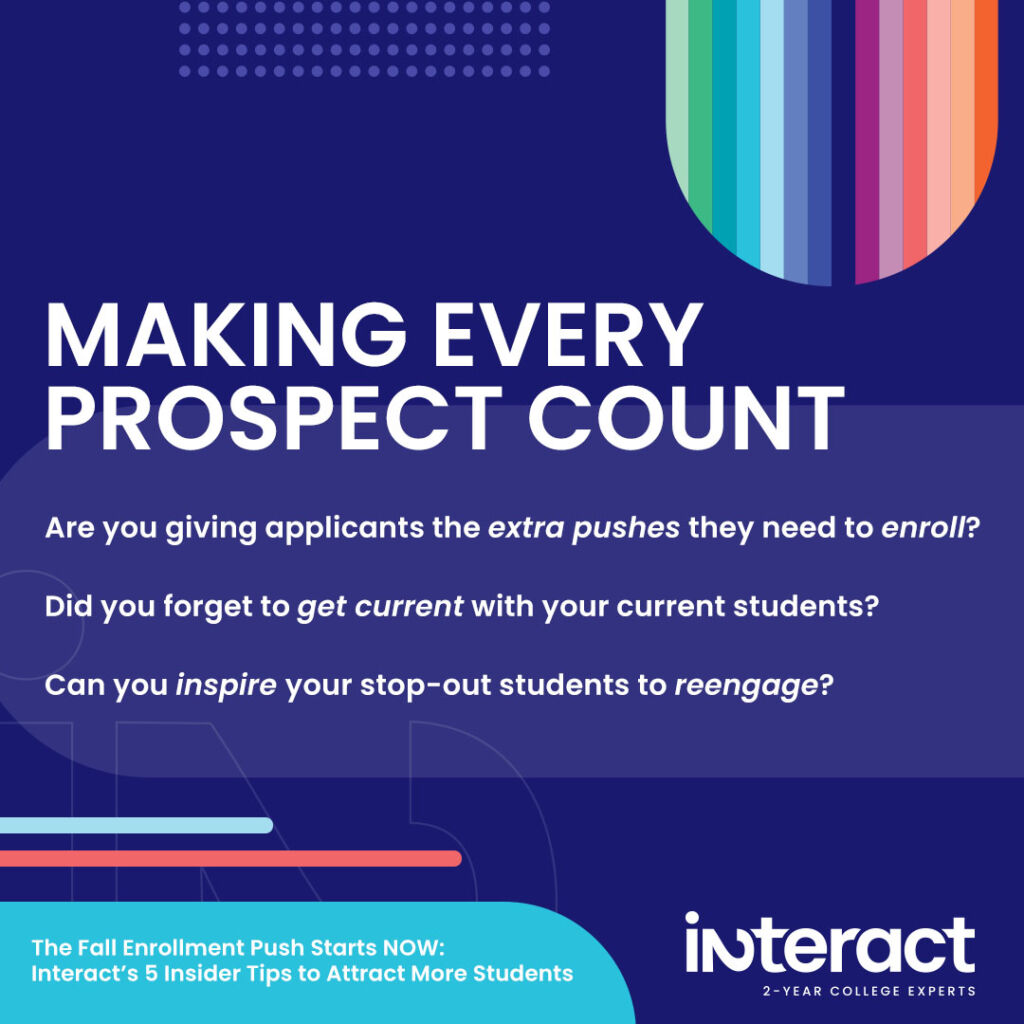
- Are you giving prospects the extra pushes they need to enroll?
- Did you forget to get current with your current students?
- Can you inspire your stop-out students to reengage?
Now is the time to give enrollment everything you’ve got. In this blog, you’ll hear from Director of Strong Workforce Strategic Communications and Marketing James Meier from the Inland Empire/Desert Regional Consortium (IEDRC) and our CEO, Dr. Diane Walleser, for tactics to increase enrollment this fall and beyond.
1. Applied but Not Enrolled: Giving Prospects Extra Nudges to Boost Fall Enrollment
Like many community college districts, the IEDRC doubles down on its outreach to high schools during February and March.
“We throw everything out there,” says Meier. From outreach to field trips with feeder schools to leveraging digital marketing, geofencing, and social media, the consortium — and its 12 regional community colleges — employs all the usual tricks to reach students … but it also has a secret weapon: sending extra reminders to indecisive students in special conversion campaigns.
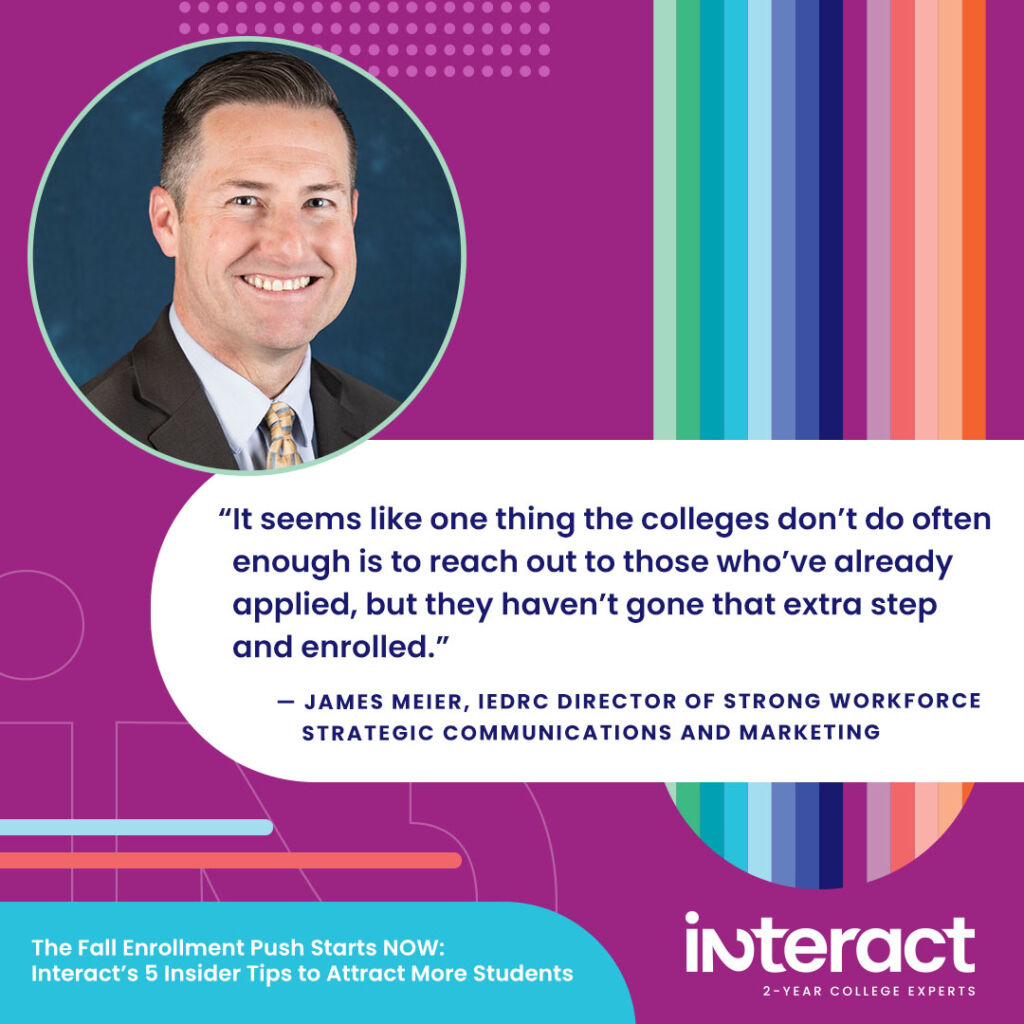
“It seems like one thing the colleges don’t do often enough is to reach out to those who’ve already applied, but they haven’t gone that extra step and enrolled,” says Meier. “They’ve stalled, possibly because of all the obstacles we as colleges throw at them, but possibly because they just got distracted by something else.”
Fall Enrollment ROI
One extra nudge that says, “Hey, you’ve got this,” might be all it takes to help students matriculate. That’s why the IEDRC started running special “conversion campaigns” for students who applied but did not enroll in 2019. Right off the bat, the colleges gained +51,700 enrollments after engagement, with a boost of more than 911,700 subscribers!
When the pandemic arrived a year later, it was a no-brainer to continue making every student count. Years later, the campaign has become a mainstay of the consortium’s outreach strategies. As Meier says, “The expectations were, ‘This can’t hurt. It can only help.’ And it certainly has.”
IEDRC has been conducting conversion campaigns with Interact for five years and counting. Over that time, the district has gained +165,700 enrollments following engagements across its colleges. Plus, it swelled its subscriber count to more than 3.5 million!

Are you targeting your students who applied but did not enroll for your fall enrollment? Try making special campaigns to give this group the extra push they need to succeed!
2. Get Current with Your Current Students
Psst! Are you forgetting someone in your outreach? Our CEO, Dr. Diane Walleser, says you can’t have stellar enrollment without strong retention.
“Don’t forget about your currently enrolled students,” cautions Walleser. “Get them registered as soon as possible for the next semester and track to see how well your students are reregistering.”
She says to schedule regular check-ins with students to help them stay on track. Most of all, remind them to enroll!
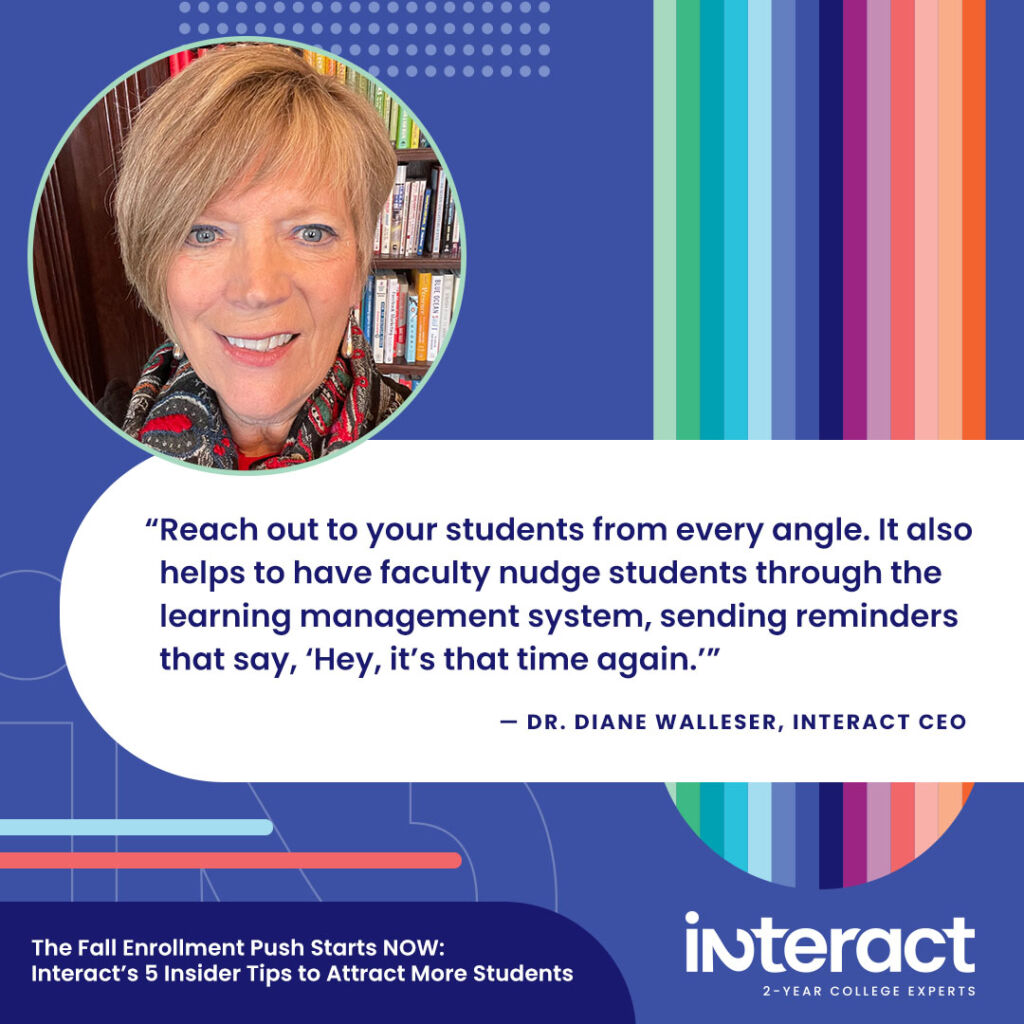
“Reach out to your students from every angle,” says Walleser. “It also helps to have faculty nudge students through the learning management system, sending reminders that say, ‘Hey, it’s that time again.’”
Sometimes, students are on the fence because competing priorities are vying for their attention. As the old saying goes, out of sight is out of mind. That’s why it’s important to regularly encourage current students to register for classes and send reminders as soon as possible.
Remember: Waiting until May to start your retention efforts is too late. By then, students are stressed about finals and aren’t paying attention. So, don’t hold back! Get cracking on your fall enrollment and retention now.
“As somebody who likes to plan, I want to know that my fall and summer are already set to go as early as April,” says Meier.
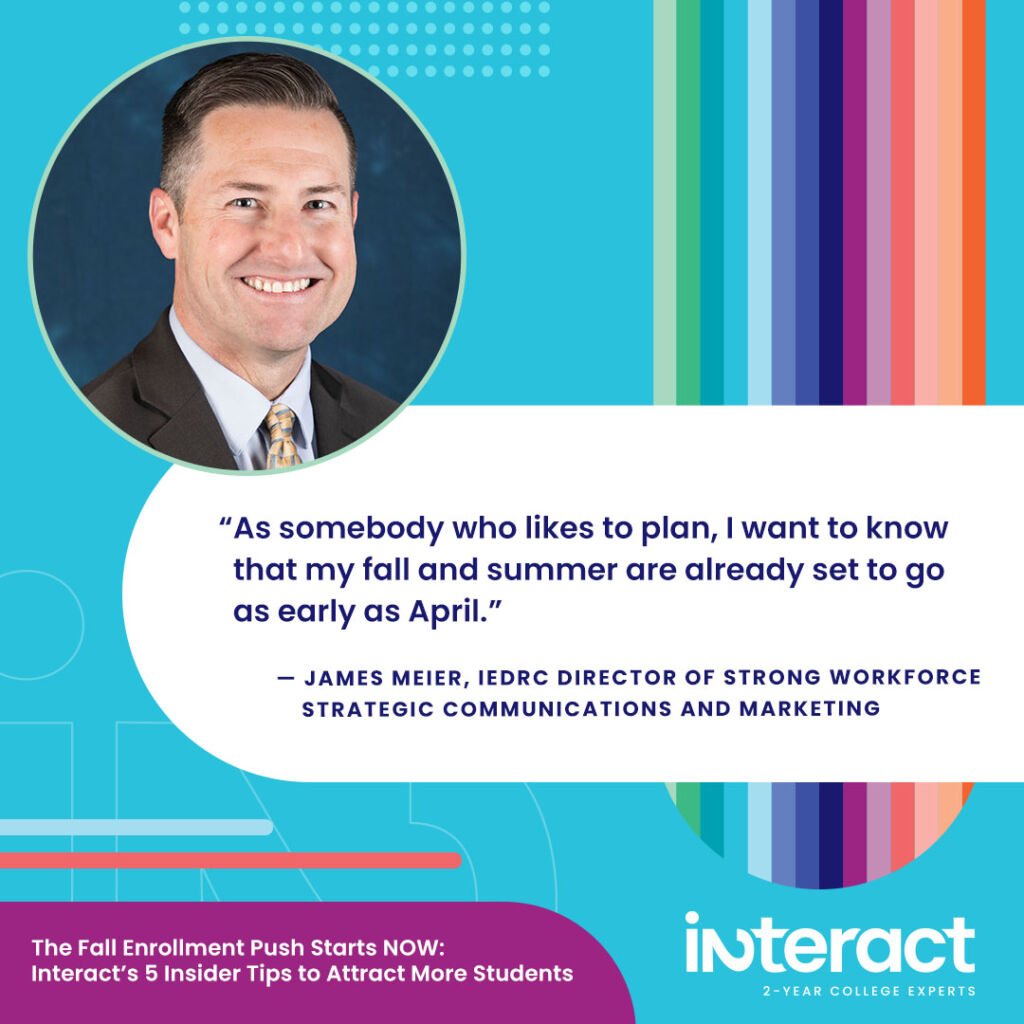
3. Start with Your Stop-Outs
It’s easy to over-focus on reaching new prospects and forget the students whose info you already have — like stop-outs.
Consider that roughly 40% of community college students do not persist from their first fall enrollment to the following fall, according to the National Student Clearinghouse Research Center. The CCCSE shares a quote from a first-generation stop-out student that says it all: “After I left, nobody said anything. Nobody emailed me or messaged me.”
That’s why our CEO says reaching out to students who have stopped out in the last five years is crucial. And while you are reestablishing a warm relationship, why not try offering them incentives to stay in touch?
“To reengage your stop-out students, help them explore their options through a career assessment or encourage them to join a career night,” suggests Walleser. “Keep letting your stop-outs know that you are there for them.”
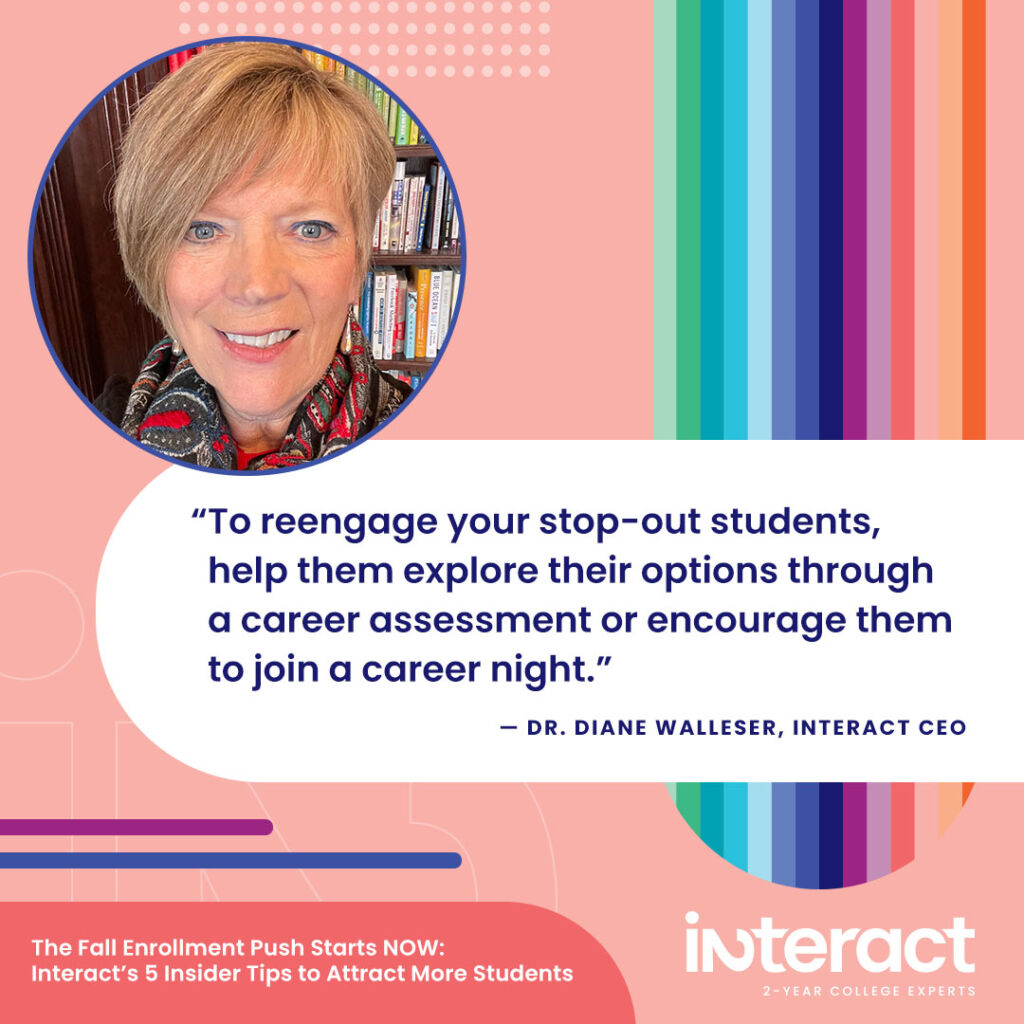
For more great tips on engaging stop-out students, check out “9 Powerful Tips to Stop Churning and Start Returning Stop-Out Students.”
3. Massage Your Audience Messaging for Fall Enrollment
While every college targets unique demographics, two audiences are usually at the top: traditional high school students and returning adult learners. And those different audiences require different messages for healthy fall enrollment.
Traditional students crave aspirational, lifestyle messaging. However, according to Meier, “When it comes to career education, many students are adult learners who didn’t go to college the first time for various reasons.”
The message for these returning students is that it’s never too late. With an education, they can make a better living in a high-demand, stable career field.
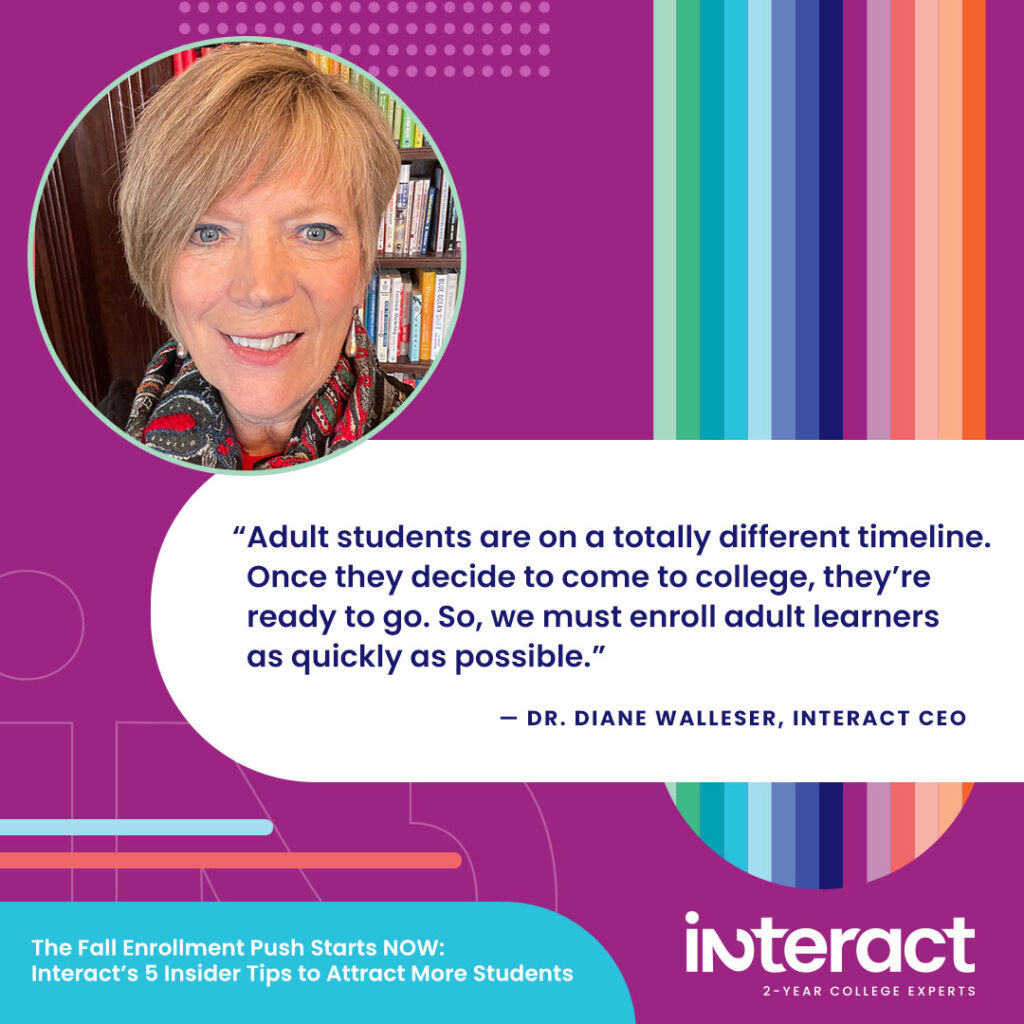
Our CEO adds, “Adult students are on a totally different timeline. Once they decide to come to college, they’re ready to go. So, we must enroll adult learners as quickly as possible.”
Walleser suggests marketing summer classes to returning learners in the spring, which gets them started quickly and ramps up to fall enrollment. Plus, pitch your short-term courses and certifications to this audience, leading us to our next tip …
4. Get Students in the Door: Push Short-Term Courses and Certifications
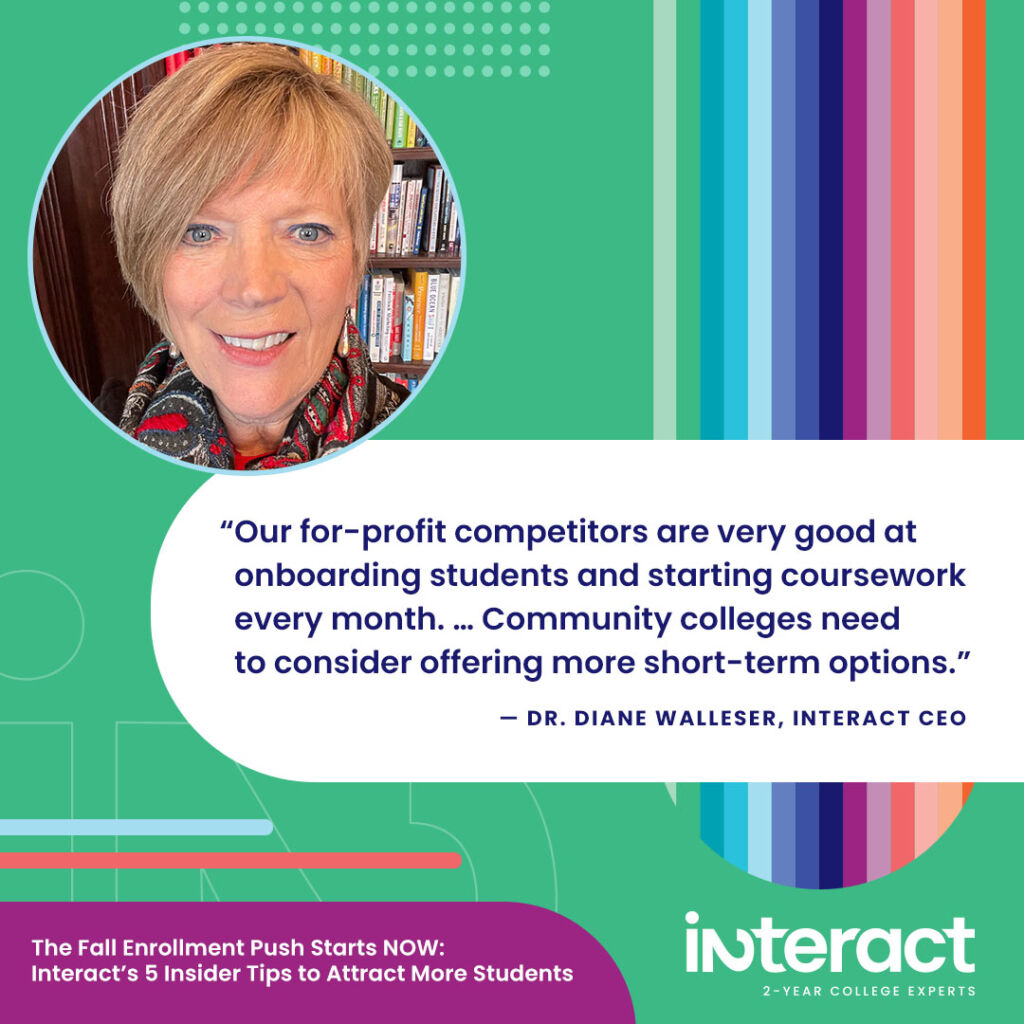
“Our for-profit competitors are very good at onboarding students and starting coursework every month,” says Walleser. “They have extremely flexible models, so community colleges need to consider offering more short-term options.”
Stepping away from the traditional 16-week structure is a growing trend. And according to Walleser, it’s the way of the future:
“If community colleges want to target adults, which is where our growth is, we need multiple ways for them to take courses.”
Meier couldn’t agree more. He says that California community colleges are increasingly offering short-term courses, especially in the wake of the pandemic.
“For-profits can offer a class immediately,” says Meier. “We aren’t that nimble, but we can say, ‘Hey, get started next month.’ And you can do a six-to-eight-week course, then continue into summer and fall until you earn that certificate or degree.”
He says offering six- or eight-week courses is a great incentive to get students started ASAP.
“Once you get them in the door, it’s much easier to keep them going,” says Meier. “If we didn’t offer those short-term classes, we’d be holding ourselves back even more than we do.”
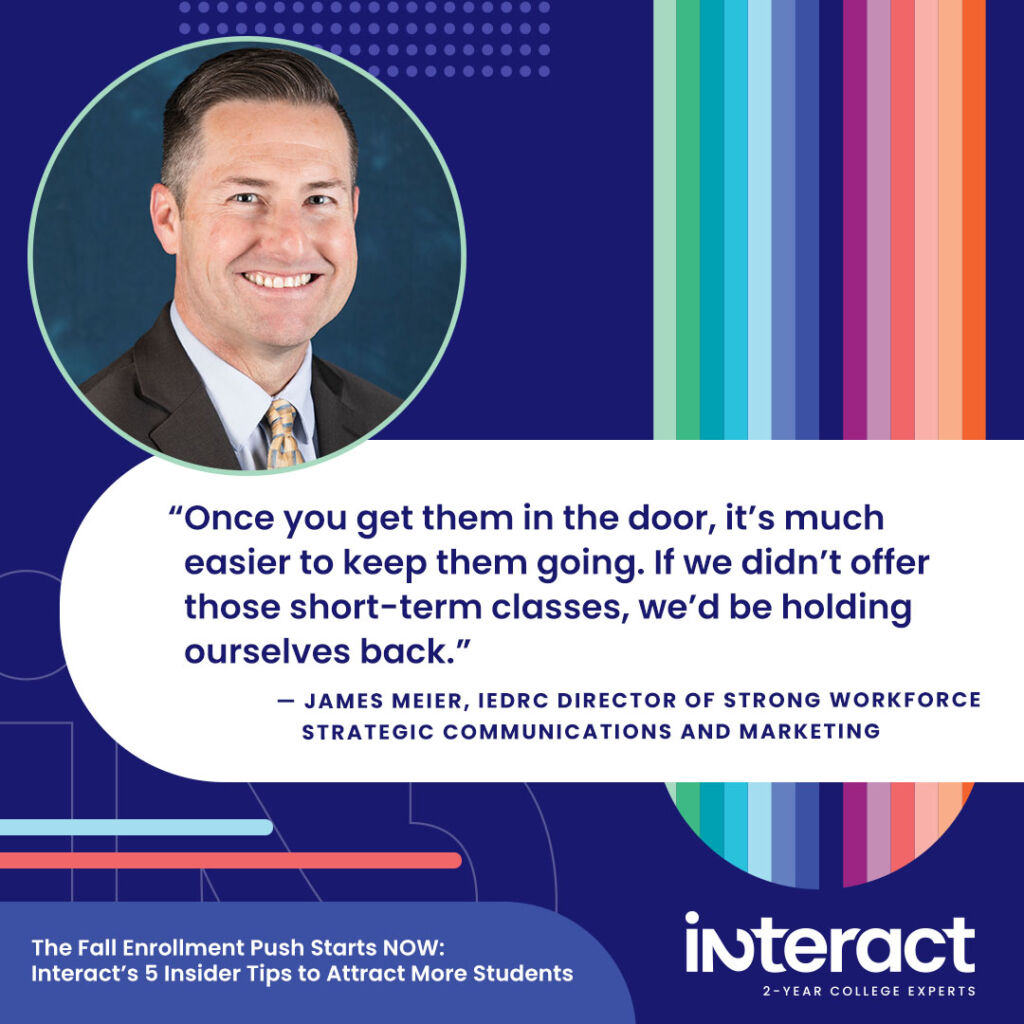
5. Don’t Rest on Your Laurels: Keep Your Fall Enrollment Fresh
This year, the IEDRC celebrates increasing enrollments in post-campaign engagements, boosting students in seats by more than 46,100 — up by +16,400 since last year!
“I know some colleges out there did not see increases, so whatever we’re doing, it’s working,” says Meier. However, he cautions, “We can’t rest on our laurels.”
In a recent blog, we discussed the looming enrollment cliff, which is the dwindling traditional college-aged population expected to decrease by 15 percent. That means that our colleges need to make every applicant count. So, why not take a page from IEDRC’s textbook and try a new conversion campaign?
“Interact has helped our marketing and PIO teams work with their institutional research folks to get the right information early on and then ensure they get the updated email lists every week,” says Meier. What could be a complicated task is broken down so everyone is on the same page to make more conversions happen.
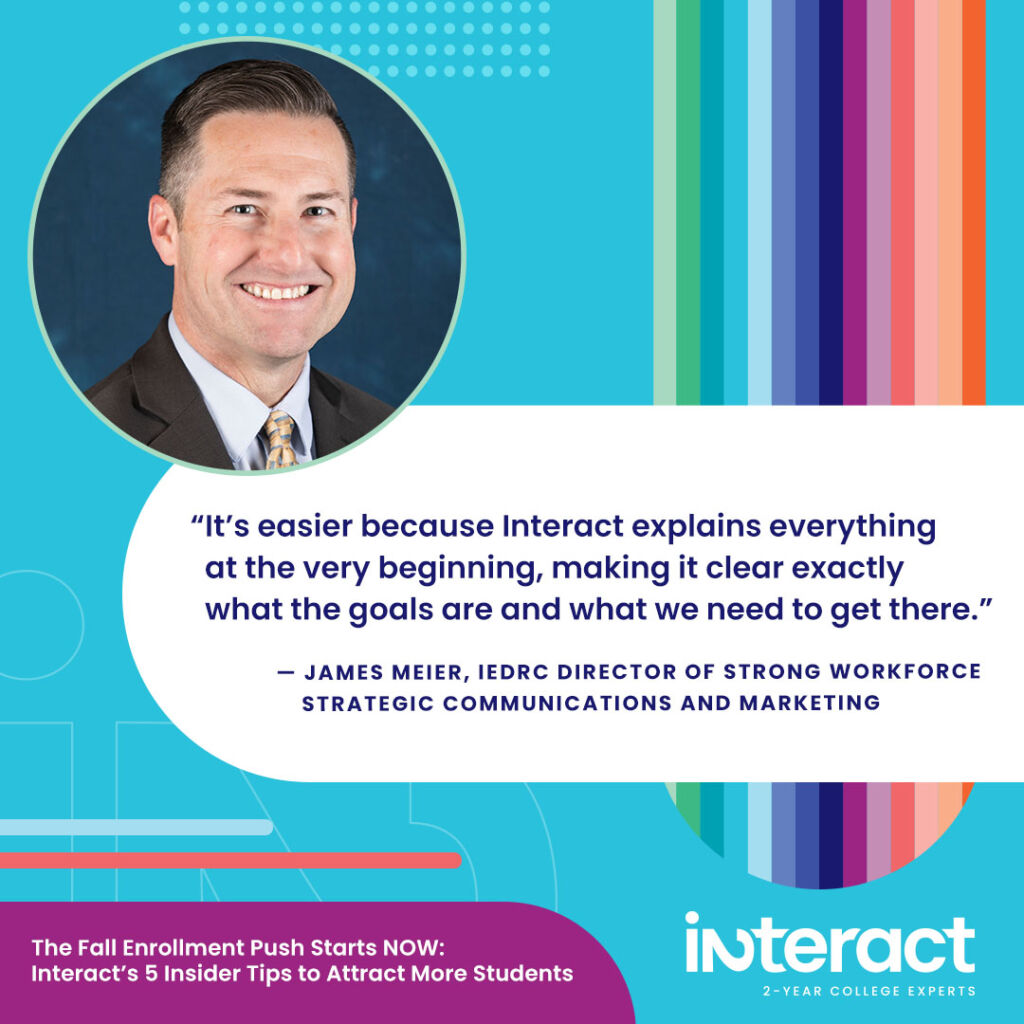
“It’s easier because Interact explains everything at the very beginning, making it clear exactly what the goals are and what we need to get there.”
So, if your school is ready to increase fall enrollment, try out some of IEDRC’s pro tips. As Meier says, don’t be afraid to experiment.
“Just getting students through that door and getting them started is a huge step,” says Meier. “It’s exciting to try new things and see what works.
“Anything we can do to keep those enrollment numbers rising each year is a huge success.”
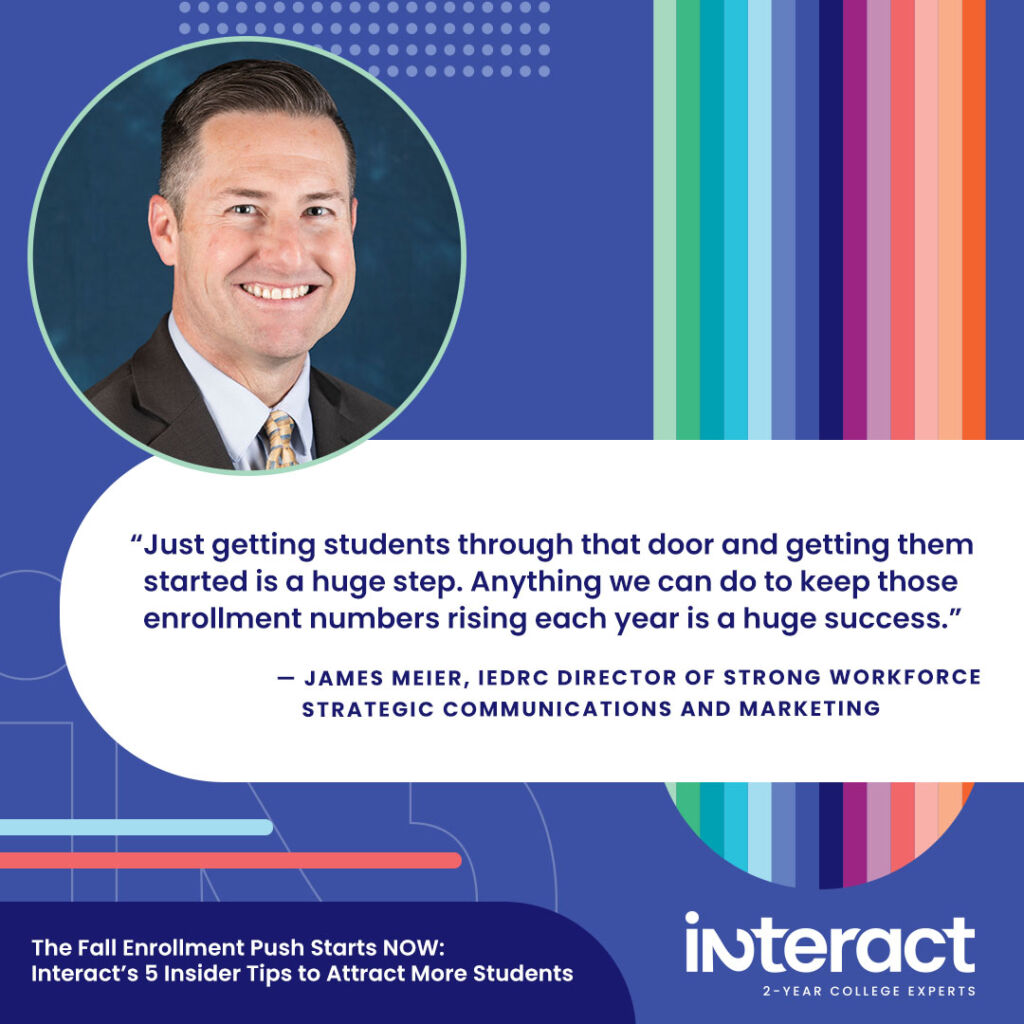
Get a head start on your fall enrollment — reach out for a free consultation to find out how we can help!



